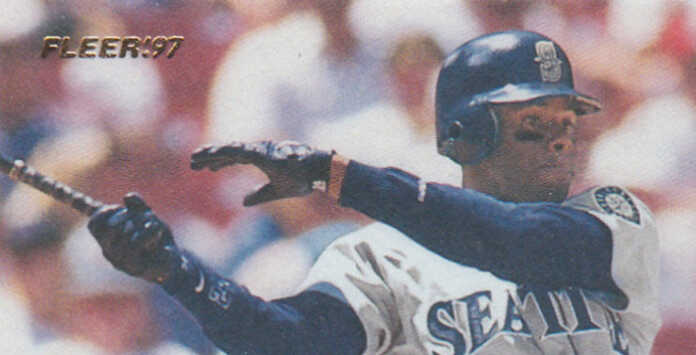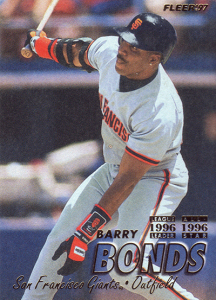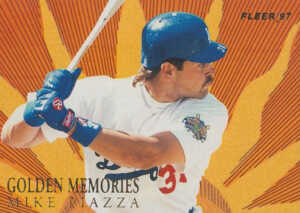
In the early- to mid-1990s Fleer was one of the companies to fully embrace the ideas of glossy card stock and gold foil (lots of it) in all of their products. But in 1996 and 1997 they did a throwback with their flagship baseball sets, opting for more traditional cardboard stock for their base cards. I don’t know if the idea behind it was to appeal to the nostalgia crowd, autograph seekers or simply just to standout in a crowded marketplace of shiny release after shiny release, but I liked it then and I still appreciate it now, even if the darned things are tough to sort through with bare hands.
With its unique for the time throwback appeal, large gimmick-free checklist and sense for simplicity, 1997 Fleer Baseball is an overlooked base set that somehow got lost in the shuffle.
When 1997 Fleer Baseball first came out I bought quite a few packs, but I was caught up in the tradition of Topps for much of the year. And when I finished that set off, there was little left in my neck of the Canadian woods to go back to it then. I did build the Series Two set immediately and tucked it away, almost forgetting about it until a couple of years ago when David Ortiz caught fire in the hobby with only a couple of rookies, that set having one of them.
1997 Fleer Baseball is a great base set that features very few gimmicks. You get 492 player cards and eight checklists. No season highlights, no league leaders, no All-Stars, just players. The design is pretty simple as well. You’ve got a full-bleed photo (a mix of vertical and horizontal) on a matte finish with the text in tasteful gold foil. League leaders, All-Stars and World Series participants are noted by a small gold foil badge.

Card backs are in full color. They feature both a second player photo (different from the front) and full career stats. I also like the short one- or two-sentence bios that are also included.
Overall, I really like the simplicity this base set brings. It’s about the players and their stats. That’s what I think a base brand should be about. And with a big checklist, it’ll likely take a couple of boxes to build. There’s no gimmicks, variations or shortprints, just something good to get behind. I bought this box hoping to get closer to finishing off a set I’d started in 1997. I did very well pulling 345 singles versus just four double. Of those singles I was able to take 75 hits off my wantlist so I was happy.
Like the gold foil, Fleer also liked their inserts during the 1990s. There’s several levels to chase here, some of which are nice and others not-so-nice.
First up are the Tiffany parallels. They’re what people would normally expect the base set to be: glossy, slippery and bright. Inserted 1:20 packs, it’d take about 450 boxes to put a set together. Yet, like a lot of parallels, commons can be had for less than a buck. I pulled one Tiffany insert and it was Mike Greenwell. Unfortunately a little of the foil on the team name was missing. It’s still a solid card, but not one I’m overly excited about.
The easiest inserts to find are the Rookie Sensations, inserted 1:6 packs. Twenty up-and-comers are featured, not that there were 20 legitimate prospects back in 1997. I pulled six as expected, the best of which was Andruw Jones.
Next up are the Golden Memories that puts the spotlight on various season highlights. There’s ten cards in the set, inserted at a rate of 1:16 packs. I pulled Paul Molitor and Mike Piazza – not too shabby. I like the sparkly sun in the background, but it just doesn’t work as a baseball card. Remove the player photo and you’ve got something to hang in the kitchen.

My favorite inserts from the ones I pulled are the Team Leaders.A profile head shot is die cut on the right set with a full-body action shot in the foreground. I love die cuts and I like portraits. The two go very well. With 28 in the set and a 1:20 insertion rate, building a complete run is a challenge but not impossible. I beat the odds slightly, by pulling two, although with the odds, this should be the norm, not the exception.
I didn’t get either of the long-shot inserts. Zone are hobby exclusives and fall 1:80 packs. Lenticular Night & Day cards fall 1:240 packs and would be considered a case hit back in the day.
Overall I was pleased with the box. There were just four doubles, a few cards showed a bit of damage but nothing major and all of the inserts came accordingly. 1997 Fleer Baseball is a great release for set builders, although hit chasers will likely be turned off by the sheer amount of cards in a box and the limited chance of getting something that could be sold for more than a couple of dollars.
1997 Fleer Baseball Box Breakdown:
Packs per box: 36
Cards per pack: 10
Total cards: 360
Cards in set: 500
Singles: 345
Doubles: 4
Triples+: 0
Inserts: 11
- Tiffany (1:20): 1 (24. Mike Greenwell)
- Night & Day (1:240): 0
- Team Leaders (1:20): 2 (16. Mark Grace, 19. Gary Sheffield)
- Golden Memories (1:16): 2 (5. Paul Molitor, 8. Mike Piazza)
- Rookie Sensations (1:6): 6 (6. Todd Hollandsworth, 10. Rey Ordonez, 11. Edgar Renteria, 15. Andruw Jones, 16. Wendell Magee Jr., 17. Neif Perez)
- Zone (1:80): 0










